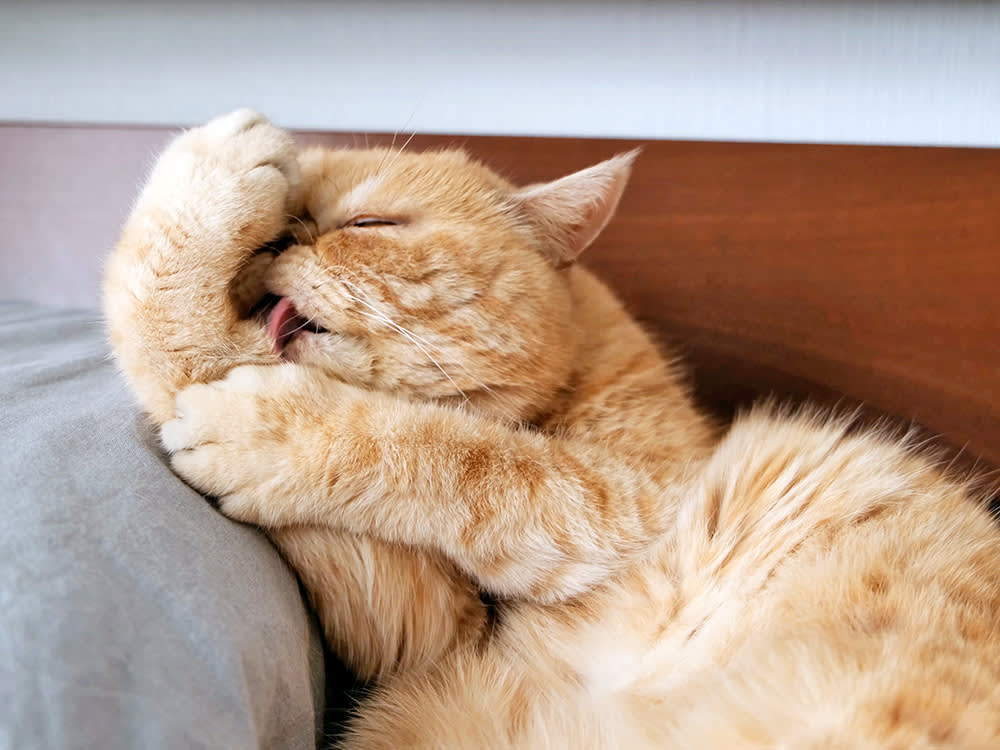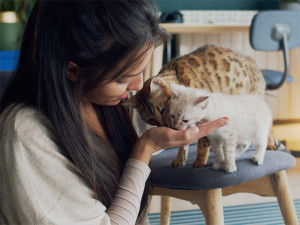Why Do Cats Clean Themselves So Much?
They are adorable little neat freaks.

Share Article
In This Article:
Why Cats Clean Themselves So Much How to Distinguish Normal Grooming from Obsessive Grooming What to Do if Cat Grooming Becomes Obsessive
You can’t think about your cat without images of your furry feline elegantly stretching their back leg long and licking their toe beans. What about the absurdly cute licking of the paws to wash their face?
It’s all adorable. But it also serves a purpose. Many, in fact. Let’s talk about why your cat is so focused on grooming and when that grooming might be a sign of stress or pain.

Why cats clean themselves so much
It may seem obvious. Cats lick themselves to get clean. They don’t like foreign substances on their fur. Even water is a foreign substance to a cat, which is why they lick any areas that may get wet. This dedication to cleanliness is a big reason that most cats don’t need help from a groomer. But there’s more to it than just staying clean.
First, grooming isn’t just licking. Cats also use their teeth to gently bite at areas where their tongue may not get the job done. For example, cats will bite at their nails, almost like they’re chewing them, to help remove the dry sheath, or bite between the toes to remove debris caught in the fur.
Second, grooming and licking aren’t just about getting clean. The best example of this is mothers licking their kittens’ nether regions as a way to stimulate them to pee and poop until they’re old enough to control their bladder and bowels.
Here are some other reasons cats spend so much time and energy grooming themselves and others.
They are regulating their body temperature.
You may splash water on your face to cool down in the summer. Cats use grooming in a similar way. Licking the fur adds moisture, which can be cooling as it evaporates, especially as the breeze moves over that fur.
They remove loose fur and skin particles.
It’s not just dirt and bits of food that cats remove during a grooming session. Loose fur can cause matting and build up if it’s not removed. Cats also shed skin cells, just like humans do. But their skin is covered by fur, so that dead skin can’t easily slough off. Grooming helps remove loose skin and fur from your cat, improving the quality of their coat and, I would imagine, their physical comfort as well.
Grooming also spreads natural oils over the skin and fur, which helps keep the coat healthy and free of painful mats and moisturizes the skin.
They are cleaning their wounds.
Cats will lick wounds. It may be more about removing blood, other fluids, and debris that stick to the wound than actually trying to heal the wound. Of course, there are differing opinions. Cat saliva does have some antibacterial properties.
But a cat’s mouth is also full of bacteria. Licking a wound can do more damage than good, not just by introducing bacteria, but also by keeping the wound wet when it may benefit from drying or scabbing, and irritating the already-damaged tissue with their rough tongue. Imagine licking your wounds? It doesn’t sound like the most sanitary option.
It’s a sign of pain or discomfort.
It’s very common for cats to lick areas that hurt, itch, or have other unpleasant sensations. In fact, intense licking can be one of the only signs a cat gives that they’re experiencing pain. It could be a broken bone, sore muscle, impacted anal gland, itching from allergies, or really anything that just doesn’t feel good.
It’s a stress-reduction tactic.
In the same way you might rub your hands together or wrap your arms around yourself when you’re stressed, your cat may groom. It can be a soothing behavior during times of fear or anxiety.
This is another reason cats lick when they’re in pain or have a wound. Those stressful moments can be calmed by the same grooming behavior that mama cat exhibited toward them from the moment they were born and throughout their kittenhood.
It can be a social activity.
Cats don’t just groom themselves. They groom other cats, pets, and people. Sometimes, they even groom inanimate objects, like blankets. In this situation, it’s often not about cleaning. It’s more about spreading scent. Cats groom each other (this is called allogrooming) to build a group scent that they share. It’s one way they recognize each other as “safe.”
They may also groom as a way of saying, “Hey, you need to respect me.” I’m not talking about dominance. If you have more than one cat, you’ve probably seen one pin the other down and groom them, seemingly against their will. It’s like a big brother sitting on their little brother.
How to distinguish normal grooming from obsessive grooming
Grooming isn’t always a good thing. Cats can become obsessive about this behavior. It’s often called overgrooming. As opposed to serving a healthy purpose, like cleaning, scent spreading, or cooling down the body, it’s a sign that something is wrong.
Cats will overgroom due to pain or discomfort, as we discussed earlier.
It’s also a common stress response. This is more than the simple self-soothing behavior we discussed above. This level of stress grooming really takes on an obsessive-compulsive quality.
You can tell the difference between healthy grooming or licking and overgrooming in a couple of key ways:
The grooming is causing physical harm: You may see hair loss in the area being groomed. More serious cases will have open sores from the constant licking.
You can’t easily distract your cat when they’re grooming: If it’s hard to interrupt the behavior and get your cat focused on something else (in other words, they won’t stop, or you stop them and they go right back to it), that’s a compulsive behavior.
This cat is experiencing significant pain or anxiety. They need support right away.
What to do if cat grooming becomes obsessive
Your first priority is a vet visit to rule out medical causes. Take video of your cat overgrooming so your vet can see the specific area they’re grooming and their body language as they groom.
Make note of any other changes to your cat’s normal behavior. If they’re less playful, wanting less attention, eating more, not sleeping well, etc. these can be clues for your vet about possible medical causes. Cats are good at hiding pain and illness. It can sometimes take more than one visit or a little advocating on your cat’s behalf to make sure there’s nothing medical going on.
Once medical issues are ruled out, you can focus on anxiety as the probable cause. If you know of a specific trigger that is causing stress or fear, remove it or work on helping your cat get comfortable with it in a positive way.
A certified feline training and behavior consultant can be extremely helpful in these cases. They can find possible triggers and give you a plan to work on those triggers and reduce stress generally.
You can help reduce stress with things like play sessions that replicate hunting, mental enrichment, and more bonding time.
Bottom line
It may seem like your cat is constantly cleaning themselves when, in fact, they may be using licking for other instinctual reasons.
They’ll lick to remove dirt, spread oils through their coat, and bond with other pets, to name just a few reasons.
Grooming and licking in an obsessive way can be a sign of pain or significant anxiety that needs your attention.
It may seem like your cat is constantly cleaning themselves when, in fact, they may be using licking for many other reasons. Removing dirt, spreading oils through the coat and over the skin, and even bonding with other pets can all be accomplished with these same grooming behaviors. And those are just some of the reasons your cat is always licking.
Grooming can also be a sign that something is wrong, especially if your cat seems obsessed with doing it. It’s important to know the difference between healthy grooming behavior and licking in a damaging way.
References
“Does a Cat Licking a Wound Help It Heal - [Vet Explains Pets].” [Vet Explains Pets], 29 Oct. 2024, vetexplainspets.com/does-a-cat-licking-a-wound-help-it-heal/opens in new tab. Accessed 7 Aug. 2025.

LeeAnna Buis, CFTBS, FFCP
LeeAnna Buis has adored cats her entire life and thought she knew them inside out and sideways. But it wasn’t until she worked with a feline behavior consultant that she fully understood how incredible, complicated, and inspiring they really are. She made a career change, starting the certification process to become a behavior consultant right away. She discovered what unique, fascinating, complex creatures cats are and knew this was what she wanted to do with her life — help others on a similar journey to truly knowing, loving, and appreciating their cats.
LeeAnna earned her certification through Animal Behavior Institute, where she received the certified feline training and behavior specialist (CFTBS) designation.
Related articles
Why Does My Cat Lick My Face?
It’s sweet, but a little much.
Why Does Your Cat Lick Plastic?
That’s an interesting choice for a snack...
Love Bite or Aggression? This Is Why Your Cat Licks Then Bites You
Cats can be such enigmas.
Why Does My Cat Lick My Hand? About This Common Cat Behavior
Since when did my cat become a dog who can’t stop licking me? We explain why.
Why Does My Kitten Lick My Nose?
No complaints, but...
Just a Nibble, or Something More? 5 Reasons Why Your Cat Bites Your Nose
Here’s why what seems like aggression may actually be affection.








